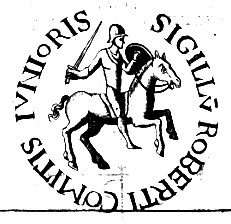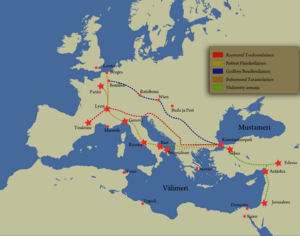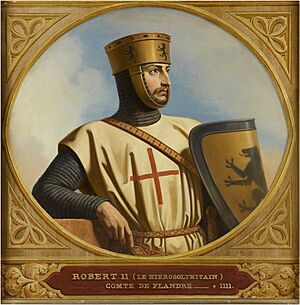Robert II, Count of Flanders facts for kids
Quick facts for kids Robert II |
|
|---|---|

Seal of Robert II
|
|
| Count of Flanders | |
| Reign | 1093 – 1111 |
| Predecessor | Robert I |
| Successor | Baldwin VII |
| Born | c. 1065 |
| Died | 5 October 1111 (aged c. 46) Meaux, Kingdom of France |
| Spouse | Clementia of Burgundy |
| Issue | Baldwin VII of Flanders |
| House | House of Flanders |
| Father | Robert I of Flanders |
| Mother | Gertrude of Saxony |
Robert II was a powerful ruler known as the Count of Flanders from 1093 to 1111. He was born around 1065 and died on October 5, 1111. People also called him Robert of Jerusalem or Robert the Crusader because of his brave actions during the First Crusade.
Contents
Robert II's Early Life
Robert was the oldest son of Robert I of Flanders and Gertrude of Saxony. His father wanted Robert to become count, so he started training him around 1086. From 1085 to 1091, Robert acted as the ruler of Flanders while his father was away.
Robert became the Count of Flanders in 1093. He worked to bring back the diocese of Arras. A diocese is an area managed by a bishop. This helped limit the power of the Holy Roman Empire in his lands. With the Pope's approval, the diocese was separated from another one in 1093 or 1094.
Robert II and the First Crusade
In 1095, Robert joined the First Crusade. This was a big military journey launched by Pope Urban II. Robert made his wife, Clementia of Burgundy, the ruler of Flanders while he was gone. He then gathered his own army, known as the army of Robert the Crusader. They joined forces with his relative, Godfrey of Bouillon.
Journey to Constantinople
The crusaders traveled to Constantinople, a very important city. There, they had to promise loyalty to the Byzantine emperor, Alexius I. They also promised to give back any land they captured to the Byzantine Empire. Robert's father had already served Alexius, so Robert had no problem making this promise. Some other leaders, however, were not happy about it. This caused a delay before they could leave the city.
Key Battles of the Crusade
Robert took part in the Siege of Nicaea. After this, the crusader army split into two groups. Robert marched with other leaders like Stephen of Blois and Bohemond of Taranto. They were a day ahead of the rest of the crusaders.
On June 30, 1097, this group was surrounded by the Seljuk Turks at the Battle of Dorylaeum. The next day, the second crusader army arrived and helped them. The two armies joined together, with Robert and Raymond leading the center. The Turks were defeated, and the crusaders continued their journey.
The Siege of Antioch
At the end of 1097, the crusaders reached Antioch. The Siege of Antioch lasted for many months. In December, Robert and Bohemund left the army briefly to find food. On December 30, they defeated an enemy army sent to help Antioch.
Antioch was eventually captured. Robert was one of the first to enter the city. However, just a few days later, the crusaders themselves were surrounded by a new enemy army. On June 28, 1098, the crusaders marched out to fight. Robert helped lead one of the main groups. The enemy was defeated, and the city was finally safe for the crusaders.
March to Jerusalem
After Antioch, there was a disagreement among the leaders. This delayed the crusade even more. Robert eventually joined the march south towards Jerusalem. In June 1099, Robert and another leader led the first group that arrived at Ramla. He also helped find wood to build machines for attacking Jerusalem.
When Jerusalem was captured on July 15, Robert supported Godfrey's claim to lead the new kingdom. On August 9, Robert marched out with Godfrey to fight an enemy army coming to help Jerusalem. Robert was part of the center of the army in the Battle of Ascalon. The crusaders won this battle. This victory helped establish the Kingdom of Jerusalem.
Robert's Return Home
At the end of August, Robert returned home. On his way back, he helped capture Latakia. This city was given back to the Byzantine emperor, just as they had promised. Robert continued home through Constantinople. He brought back a special gift from Emperor Alexius: the arm of Saint George. This important item was placed in a church in Flanders. After returning, Robert built a new monastery. Because of his actions in the crusade, he earned the nickname Robert of Jerusalem.
Robert II's Later Life
While Robert was away on the crusade, the Holy Roman Emperor, Henry IV, tried to take over parts of Flanders. Robert fought back by supporting a rebellion in Cambrai against the emperor. He also took control of several castles.
Peace was made in 1102. However, after 1105, the new emperor, Henry V, marched on Flanders with an army. Robert stopped them outside of Douai. A new peace agreement was signed. In this agreement, the emperor recognized Robert's right to control Douai and Cambrai.
Robert also supported reforms within the church. He helped leaders who wanted to improve the church.
In 1103, Robert made an agreement with Henry I of England. He offered 1000 cavalry soldiers in exchange for money each year. When Henry refused to pay, Robert allied with his overlord, Louis VI of France. They attacked Normandy. Robert led his army against Meaux. During the battle, he fell off his horse and was trampled. He died on October 5, 1111.
Robert II's Family
Robert married Clementia of Burgundy. She was the sister of Pope Callistus II. They had three children, but only their oldest son lived to be an adult. This son, Baldwin VII of Flanders, became the next Count of Flanders after Robert.
| Preceded by Robert I |
Count of Flanders 1093–1111 |
Succeeded by Baldwin VII |



